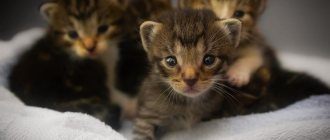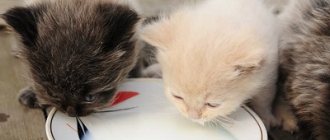Proper nutrition at every stage of life is necessary to raise a healthy kitten. Feeding may seem simple at first, but there's more to it than meets the eye, especially if you have a 16-week-old kitten.
To know how much and what to feed a four-month-old kitten, you should always follow its needs and the advice of your veterinarian. As a rule, the kitten should be fed at least four times a day, with portions of 1/3 to 3/4 cup per meal.
Physical development of a kitten from 3 to 6 months
At three months of age, the kitten has developed all its baby teeth and they even begin to fall out. If the teeth do not fall out by the time the kitten is about six months old, your veterinarian may recommend removing them when the kitten is spayed or neutered.
Baby teeth that do not fall out are called retained deciduous teeth, and they can cause problems for adult teeth if they do not fall out or are not removed in time.
A typical cat will have 26 baby teeth and 30 adult teeth, so there is a lot of teething going on over the course of several months. You may find baby teeth lying around the house, but in most cases the kitten will swallow the teeth.
By the age of three months, the kitten's eyes will be an adult color. Baby blue eyes will change to permanent adult eye color if the cat does not have the genes to have blue eyes.
Between three and six months, the kitten's body shape will begin to fill out. This means that the kitten will begin to become more muscular and transition from a pot-bellied baby to a slender adult.
What is better for a 4 month old kitten, wet or dry food?
The wet versus dry food debate is not new, but for the most part, a four month old kitten will generally do well on a wet food diet. You can introduce wet food while weaning your kitten at 8 weeks of age. If your kitten doesn't like wet food, you can gradually introduce dry food or kibble by adding it in small portions to his meals. Remember that when switching a kitten to a new food, you need to do it slowly and patiently.
Keep in mind that when your kitten is six months old, her baby teeth will begin to fall out. At this time, it is best to give your kitten dry food that he can chew to soothe his sore gums.
© shutterstock
Changes in a kitten's behavior from 3 to 6 months
Kittens sleep a lot when they are first born, but as they grow, they will spend less time sleeping and more time playing and exploring.
Between three and six months of age, a kitten is brave enough to test its physical limits by putting things in its mouth and approaching other animals to see what will happen.
The first few months of socialization with its littermates and mother will pay off over the next three months as you begin to see the kitten's personality develop. If he has not received adequate socialization, he may develop problems with aggression.
Teething is for kittens of this age. Chewing furniture, toys, and even certain items that a kitten shouldn't chew is an attempt to help baby teeth fall out.
This behavior should be allowed but limited to safe toys. Kitten proofing your home is often necessary to keep items such as electrical cords out of your home, as well as to keep your belongings away from your kitty's tiny but sharp teeth and claws.
Most kittens are sexually mature by the time they reach six months of age, but the age can vary from cat to cat based on breed.
Once a cat reaches sexual maturity, she may begin to act differently due to the hormones that circulate in her body. Female kittens may exhibit behaviors such as crying and raising their tail in the air, while male kittens may become more aggressive.
Spaying or neutering your kitten will eliminate the behavior caused by hormones.
Common Digestive Problems
Feeding at 4 months is a challenging task for kitten breeders. If food is not given in porridge form, the animal may become constipated. And when prohibited foods are included in the diet, diarrhea occurs. In such a situation, the question arises: what is the treatment for diarrhea in a 4-month-old kitten? In what cases can you cope on your own, and when is it better to go to a veterinary clinic?
© shutterstock
You should contact your veterinarian immediately if:
- Vomiting and diarrhea are present at the same time;
- There is diarrhea with blood;
- The disorder recurs more than 4 times a day.
Self-treatment involves a daily starvation diet. You can give the kitten a rehydron solution or salted water. A decoction of rice or a mixture of oak bark helps stop diarrhea when it is caused by poor diet. A decoction of flax seeds or oatmeal also perfectly helps eliminate the symptoms of the disease.
A recovered animal can be given deworming tablets, as they are often the cause of loose stools.
Children's smecta and activated charcoal should be given in case of illness. Bifidobacteria or lactobacilli can be given with a small amount of food on the second day of treatment.
When treating at home, you do not need to prescribe antibiotics to your cat yourself. At 4 months they will destroy all the microflora of his intestines. When diarrhea is severe, it is worth finding out the cause of the disease and eliminating it.
Health and care of a kitten from 3 to 6 months
The kitten should have already had its first veterinarian visit and received its first FVRCP shot at about two months of age, but that's not all a growing kitten needs. Three to four weeks after the first vaccination, or around three months of age, a second FVRCP vaccination is given.
After about a month, the final FVRCP vaccination is given along with the rabies vaccination. During these three months, your veterinarian may also discuss other vaccination options with you, depending on your kitten's lifestyle and risk of infection. These vaccinations are incredibly important to help keep your kitten healthy.
Spaying and neutering are very common surgical procedures, and most kittens will have undergone one of these procedures by six months. Females are spayed and males are castrated, but both operations involve the removal of reproductive organs.
With the removal of these organs, fewer sex hormones are produced, the cat is unable to reproduce, and the risk of many cancers is eliminated or greatly reduced.
Your veterinarian will advise you on the best time to spay or neuter your kitten and may also recommend pre-operative blood screening before surgery.
This blood screening will not only show whether the kitten is healthy enough for anesthesia, but will also establish a baseline of normal values for the kitten. These baseline values will be useful for comparison of future blood tests.
It is important to start preventing parasites as soon as they are old enough or gain enough weight. Talk to your veterinarian about options for preventing intestinal parasites, fleas, ticks and heartworms at your first veterinarian visit. These medications are often given to your kitten monthly, but some are needed less frequently.
Diet restrictions
At 4 months all freshwater fish are prohibited. You should also avoid other seafood. Sausages, spices and cheese are also strictly prohibited at exactly 4 months. If you are interested in the health of your growing cat, do not give her sweets. An animal will not be able to report a toothache, and dentists for pets are rare and expensive.
There should be no chocolate in your diet at all. This product contains the poison theobromine, which can easily cause death in cats after poisoning.
Remember that the life of a little creature completely depends on you. Control not only his games, but also his daily diet.
Legumes should also not be added to food at 4 months. Pork meat is not harmful to cats, but it is too fatty for their babies. But it is better not to take information that cats love milk as a guide to action. If you want to feed a mischievous person milk, it is better to choose goat milk than cow milk. Goat milk is much closer in composition to cat milk .
Fruits, borscht, cutlets and other sets of food from the owner's refrigerator are not suitable for feeding kittens at 4 months. And the time has not yet come for feeding with fresh grass. The most convenient way is to create a menu for your baby for a week, then you will definitely not forget what to buy and prepare for your pet.
Nutrition for a kitten from 3 to 6 months
Kittens between three and six months of age should eat an approved kitten food to meet all their nutritional needs. They will continue to eat this food until they are nine to twelve months old.
As your kitten approaches six months of age, you may need to reconsider his diet if he is gaining too much weight.
Each kitten food contains a different number of calories per cup of food, so you will need to follow the feeding recommendations on the bag or can or work with your veterinarian to determine how much food your particular kitten needs.
The average kitten usually needs about 1/2 cup of medium dry kitten food per day.
Features of feeding a kitten
You need to feed a kitten for 3-4 months differently than an adult animal. At this age, the baby continues to grow actively and for harmonious development he needs frequent meals in small portions.
How many times a day should you feed your pet?
How many times a day to feed a kitten depends on its age. At 3 months, the baby should receive food 5-6 times a day. You can feed a 4-month-old kitten 4-5 times a day.
Important! A 3-4 month old kitten is unable to control its appetite and is prone to overeating. Therefore, he needs to be fed often, but little by little, and not put the entire daily portion in a bowl.
Food volume
The serving size is affected not only by the age, but also by the weight of the pet. The average daily amount of food for a 3-4 month old baby is determined at the rate of 150-200 g per 1 kg of body weight. It is important to take into account the breed and activity level of the baby. An active large pet needs to be fed more than its small, phlegmatic counterpart.
On a note. The daily drying rate for a pet can be easily determined from the table on the package. And wet food is packaged in hermetically sealed bags designed for 1 feeding.
Vitamins and minerals
Not all owners know how to properly prepare a diet for their pets. And poor nutrition leads to an imbalance of nutrients. To ensure that the baby receives all the necessary elements, fortified supplements, such as Gimpet, Canina or Hartz, are additionally introduced into his menu. Since an excess of microelements is no less dangerous than their deficiency, before giving your baby such supplements, you need to consult a veterinarian.
If feeding the kitten consists of dry food or canned food, then there is no need for vitamin complexes.
Can kittens eat baby food?
At 3-4 months, the pet is quite capable of digesting solid food. Therefore, there is no need to give him dry milk formula. If desired, you can feed a 3-month-old kitten with canned meat or vegetable purees that do not contain starch, onions, spices and salt. Also at this age, the baby is allowed to give children's yoghurts and curds.
Training a kitten from 3 to 6 months
The period between three and six months is important for teaching the kitten where it can and cannot go in the house, what objects it can play with, and how to respond to its name.
Treats, verbal praise and affection should be used to reinforce good behavior.
Litter box training should be natural, but there are special litters designed to attract kittens. Make sure your kitten can get in and out of litter boxes and knows where to find each one in the house.
If you have one kitten, you should have at least two litter boxes in different locations, ideally on each floor of the house.
Water in the animal's diet
From the school course we know that a living organism consists of almost 80% water. Water plays a fundamental role in metabolism and the process of hematopoiesis. The conclusion is obvious - dehydration is deadly for small kittens.
An adult animal can fight dehydration for 2-3 days and despite extensive intoxication, the cat will survive if it receives help. When it comes to a kitten, the period is reduced to a day. Without access to water, the baby quickly loses strength, his kidneys, liver, and then his heart fail.
If you choose a commercial diet for your kitten, make sure he drinks after every meal.
Everything, even high-quality food, contains preservatives that provoke thirst. With a natural type of feeding, a kitten may be reluctant to drink because it receives a lot of moisture from food.
While the kitten is small, you should place several drinking bowls in accessible areas. A kitten may refuse to drink water because it is stale or warm. Clean drinking bowls and change the water at least once a day. In hot weather, the water needs to be changed more often. When water heats up, pathogenic bacteria quickly multiply in it, and this is a direct path to diarrhea and other problems with the gastrointestinal tract.
Diet recommendations according to the age of the kitten
A 2-4 month old kitten has already developed sharp teeth; he should be able to eat from a bowl himself. Intensive growth and development of the animal requires a balanced and varied diet. The basis of the diet is lean meat, vegetables (preferably boiled) and porridge. The cereal should be boiled in a large amount of water so that the resulting porridge has a liquid consistency. Half of the diet consists of low-fat sour milk.
From 4 to 6 months, the animal’s body actively builds and strengthens muscle mass. The basis of the diet is beef and chicken, cut into small cubes and offal. Fermented milk products are allowed, but in smaller quantities. Cow's milk should be removed from the diet. Porridges are cooked with less water to make the consistency thicker. It is recommended to introduce boiled and raw vegetables, cucumbers, and zucchini into the kitten’s diet.
The animal's nutrition expands from 6 months. All products should be cut into large cubes, and porridge should be cooked more crumbly. It is during this period that it is recommended to include industrial feed in the diet, according to the age category of the animal.
Approximate diet for a week with the permissible frequency of consumption of certain foods
| Product | Quantity per week |
| Beef | Daily |
| Boiled chicken | Up to 4 times. |
| By-products (chicken and cow) | Up to 3 times, and the liver - no more than once. |
| Fish - exclusively boiled, without bones, preference is given to sea fish | Cat - up to 2 times, cat - no more than 1 time. |
| Chicken egg yolk | Up to 2 times. |
| Porridge on water - oatmeal, rice | Daily. |
| Fermented milk products | Daily. |
| Low fat cottage cheese | Up to 4 times. |
| Vegetables (cooked or raw) | Up to 3 times. |
| Greens – spinach, wheat germ | Up to 2 times, as an additive to meat. |
| Brewer's yeast | Up to 4 times. |
The kitten's bowl should always contain clean drinking water (boiled or filtered, purified). It should be changed daily.
What to feed a kitten
Four months is a difficult stage for a small animal. This is influenced by stress factors: moving, new surroundings, changing baby teeth, deworming, vaccinations. Against the background of emotional fatigue, the kitten may be malnourished, lose weight, and suffer from digestive disorders.
At this point, the new owner wants to reduce discomfort as much as possible with a variety of foods. However, this is not the right approach. To reduce stress, it is necessary to eliminate irritating factors. Therefore, veterinarians advise starting with establishing the habit of a regular menu.
Before choosing what to feed your kitten, veterinarians advise familiarizing yourself with the different types of diet.
- natural products;
- prepared feed;
- mixed diet.
Important! Mixed feeding, that is, the inclusion of natural food in the diet along with ready-made food, is not recommended, as it causes a number of problems with the health of the gastrointestinal tract.
Natural products
By 4 months, kittens' teeth begin to change, so they need solid food rich in protein. The diet of natural products is becoming more varied. The owner is allowed to include new meat ingredients, fermented milk products, more vegetables and cereals.
Feeding natural food is the best option for cats.
It is easier to digest, allows you to introduce new foods into the diet and change it in accordance with the needs of the animal.
- saving money. Buying natural products is cheaper than ready-made high-quality food (Premium, Super-premium);
- control. The owner can monitor the amount of vitamins, minerals, calorie content, and nutritional value of the diet, and change them to suit the pet’s needs;
- visibility. When feeding regular food, it is easy to identify the source of a food allergy when specific symptoms are detected.
- waste of time. For a kitten, food is prepared separately; food cannot be given from the human table;
- impossibility of long-term storage. Natural food spoils quickly, so you have to cook it every 1–2 days;
- Preparation. Kittens do not recognize cold food, so it must be warmed before each feeding.
When feeding natural foods, you can go in three ways: give only raw food, feed homemade semi-finished products, or provide a mixed diet of raw and prepared foods.
List of allowed natural food for kittens 4 months:
- boiled low-fat meat - beef, veal, chicken, turkey, rabbit. You can grind it and give it boiled minced meat;
- low-fat fermented milk products – kefir, fermented baked milk, cottage cheese in large quantities (will help strengthen teeth and bone tissue);
- fillet of lean sea fish (without bones, fins, scales) - boiled, chopped;
- finely chopped boiled offal (beef, poultry);
- eggs - raw, boiled, with vegetables, cereals;
- raw or boiled grated vegetables - zucchini, pumpkin, cabbage;
- cereals – cooked in broth (rice is better for kittens);
- grass - you can buy it at a pet store or grow it yourself (oat, wheat sprouts).
If the kitten is growing normally, without delays, then it does not need an additional portion of carbohydrate food. Therefore, you should not exceed the norm of porridge or add it as a filler.
Industrial feed
Currently, many owners are introducing their pets to commercial food. However, not everyone knows how to choose ready-made food correctly.
Pet stores offer three types of industrial food: dry, semi-moist and wet. It is also divided by class. Premium and Super-premium are recommended for kittens, as they are as close as possible in composition, nutritional value and taste to natural food.
- balance. Manufacturers took into account the needs of animals, so they included all the necessary nutrients and beneficial substances (amino acids, vitamins, minerals);
- ability for long-term storage. When closed, they are stored for a long time under optimal conditions. For example, wet and semi-moist food - in the refrigerator;
- convenience. The number of servings and dosage are indicated on the package, which eliminates the need to count them each time.
- high cost. It is recommended to feed kittens with high quality food, so ready-made food will cost several times more than natural products;
- uncertainty about quality. Popular brands are often counterfeited, so you need to choose food carefully.
What to feed one-month-old kittens
Month-old kittens need to be gradually accustomed to the food that adult animals eat. Include the following foods in your diet:
- semolina, oatmeal with milk or water;
- egg yolk (boiled or raw);
- cottage cheese (diluted with milk to a mushy state);
- sour cream, cream;
- boiled vegetables (carrots, zucchini, pumpkin);
- chopped boiled meat (beef, poultry);
- boiled sea fish (hake, pollock, cod) without bones, cut into small pieces.
If the kitten grows up without a cat, give it goat's milk, which must be mixed with water in a ratio of 4:1. It is not advisable to feed whole cows. It is better to replace it with a mixture or powdered milk diluted with warm water.
The daily food intake for a one-month-old kitten should be approximately 120 g. Starting from the age of 1.5 months, add soft varieties of cheese to the diet. Vitamin and mineral supplements are also necessary; they ensure the normal development of the skeletal and muscle systems, strengthen the immune system, and improve the quality of the coat. To select the most suitable drugs, it is better to seek advice from a veterinarian.
Ready-made feed
What ready-made food should I feed small kittens? And at what age can you do this? The popularity of ready-made pet food is increasing every day. But this is actually a convenient opportunity to feed kittens at home. The composition of purchased food includes important elements necessary for the kitten to grow fully. Each manufacturer offers food with its own specific characteristics. Some take the consumer at a price, others guarantee the quality of the product, while others offer a combined product with vitamins and minerals.
Since we are talking about small creatures, in this case you should choose a special direction of food - specifically for kittens. This is the food you need to start accustoming your pet to store-bought products. First of all, offer your pet canned food; you can gradually add dry food to it. And if desired, by gradually increasing the percentage of food to canned food, you can completely switch your pet to dry food. Let's talk about specific manufacturers of canned food for kittens and cats.
Bosch Sanabelle wet food
The product in this category belongs to super-premium food. They bring it to us from Germany. The distinctive features of the product are its perfectly balanced composition. Of the entire volume of the product, protein alone accounts for 35% and almost all protein is of animal origin. Bosch Sanabelle also contains almost 7% mineral additives.
Among the advantageous features we highlight:
- decent quality;
- no artificial additives;
- easy purchase option.
Disadvantages include the presence of maize and cellulose in the product, to which some kittens have an allergic reaction.
Hills food for kittens
Hills is another representative of the premium brand line.
Product advantages:
- vitamins and minerals included;
- ease of purchase.
Cons of Hills:
- the product contains a high content of carbohydrates, which are poorly absorbed by the kittens’ body;
- the composition is dominated by vegetable protein;
- allergenic food;
- a lot of liquid in the package.
ProPlan Junior
Proplan is a common type of premium kitten food. Pro Plan is a fairly common type of food for cats, so you can buy it in most stores that sell pet supplies.
The food has a lot of advantages:
- variety of species;
- the presence of natural meat in the recipe;
- there are prebiotics;
- balanced diet for kittens.
Among the minuses we highlight:
- the presence of preservatives in the product;
- the feed contains soy and corn;
- Vegetable protein predominates in the composition.
In any case, the choice of nutrition method is yours. The main thing is to immediately decide what and how much to feed the kitten, and what to give preference to – price or quality.
Authorized Products
Small animals allowed on the menu:
- Meat – served raw, boiled or scalded with boiling water. Only low-fat varieties are suitable. Meat products should make up from 60 to 80% of the total daily food intake.
- Liver – no more than 2 times a week.
- Porridges – any are suitable, except semolina. All kittens are not fans of cereals, but they contain many substances that the growing body needs. It is recommended to mix meat and porridge in a ratio of 2 to 1.
- Vegetables - any, except potatoes, served boiled or raw.
- Chicken eggs - small pets can only be given the yolk. Its consumption is also allowed in raw form, but not more than once every 7 days. The yolk of quail eggs can be consumed simultaneously with the white.
- Fermented milk products - any, but with a minimum percentage of fat content. The exception is sour cream; giving it to kittens is strictly prohibited.
- Oil – not vegetable oil, but Vaseline is recommended.
- Brewer's yeast - affects the coat of a small pet.











